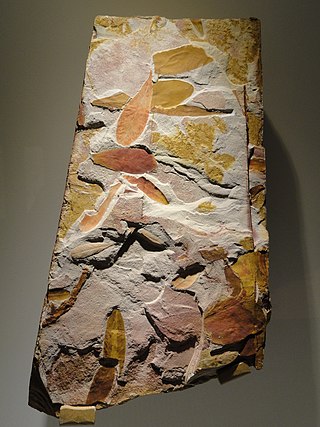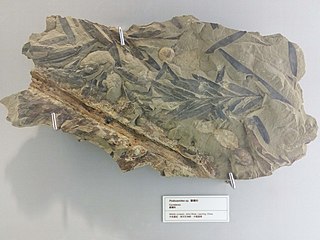
In botany, a stoma, also called a stomate, is a pore found in the epidermis of leaves, stems, and other organs, that controls the rate of gas exchange between the internal air spaces of the leaf and the atmosphere. The pore is bordered by a pair of specialized parenchyma cells known as guard cells that regulate the size of the stomatal opening.

Cycads are seed plants that typically have a stout and woody (ligneous) trunk with a crown of large, hard, stiff, evergreen and (usually) pinnate leaves. The species are dioecious, that is, individual plants of a species are either male or female. Cycads vary in size from having trunks only a few centimeters to several meters tall. They typically grow very slowly and live very long. Because of their superficial resemblance, they are sometimes mistaken for palms or ferns, but they are not closely related to either group.

Glossopteris is the largest and best-known genus of the extinct Permian order of seed plants known as Glossopteridales. The genus Glossopteris refers only to leaves, within a framework of form genera used in paleobotany. Species of Glossopteris were the dominant trees of the middle to high-latitude lowland vegetation across the supercontinent Gondwana during the Permian Period. Glossopteris fossils were critical in recognizing former connections between the various fragments of Gondwana: South America, Africa, India, Australia, New Zealand, and Antarctica.

Bennettitales is an extinct order of seed plants that first appeared in the Permian period and became extinct in most areas toward the end of the Cretaceous. Bennettitales were amongst the most common seed plants of the Mesozoic, and had morphologies including shrub and cycad-like forms. The foliage of bennettitaleans is superficially nearly indistinguishable from that of cycads, but they are distinguished from cycads by their more complex flower-like reproductive organs, at least some of which were likely pollinated by insects.

Williamsonia is a genus of plant belonging to Bennettitales, an extinct order of seed plants. Within the form classification system used in paleobotany, Williamsonia is used to refer to female seed cones, which are associated with plants that also bore the male flower-like reproductive structure Weltrichia.

Pachypteris is a Mesozoic pteridosperm genus of fossil leaves. It has either been aligned with the peltasperms or the corystosperms.

Nilssonia is a genus of fossil foliage traditionally assigned to the Cycadophyta either in Cycadales or their own order Nilssoniales, though the relationships of this genus with the Cycadales have been put into question on chemical grounds.

Zamites is a genus of sterile foliage known from the Mesozoic of North America, Europe, India and Antarctica through the Eocene of North America. It was erected as a form taxon for leaves that superficially resembled the extant cycad Zamia, however it is now believed to belong to a similar but phylogenetically different group, the cyacadeoids (Bennettitales). The fronds are linear or lanceolate in shape, and pinnately compound, with pinnae with parallel veins and smooth margins, and symmetrical and constricted at the base where they are attached obliquely to the upper surface of the rachis. It has been interpreted as a Bennettitalean plant in the family Williamsoniaceae. It is associated with the ovulate cone Williamsonia and male cone Weltrichia.
This article records new taxa of fossil plants that are scheduled to be described during the year 2015, as well as other significant discoveries and events related to paleobotany that are scheduled to occur in the year 2015.
This article records new taxa of plants that are scheduled to be described during the year 2018, as well as other significant discoveries and events related to paleobotany that occurred in the year 2018.

Almargemia is a genus of fossil leaves from the Early Cretaceous of Portugal produced by members of the Zamiaceae. It was erected by Rudolf Florin based on macrofossil material with preserved cuticle.

Podozamites is an extinct genus of fossil conifer leaves. In its broader sense, it has been used as a morphogenus to refer to any broad leaved multi-veined conifer leaves. Modern broad-leaved conifers with a similar form include Agathis in the family Araucariaceae and Nageia in Podocarpaceae, with some Podozamitessensu lato probably belonging to the same families.

Otozamites is an extinct form genus of leaves belonging to the Bennettitales.
Nilssoniopteris is an extinct form genus of leaves belonging to the Bennettitales. Leaves are slender and often entire-margined (smooth-edged), though some species have dissected leaves with numerous small segments extending down to the rachis of the leaf. Nilssoniopteris-like leaves are distinguished by their syndetocheilic stomata, indicating bennettitalean affinities. Similar "taeniopterid" leaves are placed in the genus Nilssonia if their stomata are instead haplocheilic, or Taeniopteris if the cuticle is not preserved. Leaves of Nilssoniopteris vittata from the Middle Jurassic of England are associated with bisexual Williamsoniella reproductive structures.

Cuticle analysis, also known as fossil cuticle analysis and cuticular analysis, is an archaeobotanical method that uses plant cuticles to reconstruct the vegetation of past grassy environments. Cuticles comprise the protective layer of the skin, or epidermis, of leaves and blades of grass. They are made of cutin, a resilient substance that can preserve the shapes of underlying cells, a quality that aids in the identification of plants that are otherwise no longer visible in the archaeological record. This can inform archaeobotanists on the floral makeup of a past environment, even when surviving remains from the plants are limited. Plant cuticles have also been incorporated into other areas of archaeobotanical research based on their susceptibility to environmental factors such as pCO2 levels and stresses such as water deficit and sodium chloride exposure. Such research can help to reconstruct past environments and identify ecological events.
Eoginkgoites is an extinct form genus of bennettitalean leaves from the Late Triassic of North America. Despite its palmate (hand-shaped) appearance similar to some early ginkgo species, it belongs to a different gymnosperm order, the Bennettitales. The leaf is deeply segmented into five to seven narrow, club-shaped lobes which twist around a very short rhachis. This leads to an overall fan-shaped leaf situated at the end of a long petiole. The leaf has paracytic stomata and veins which strongly branch and lead to a marginal vein at the edge of each leaflet. These structural traits are all shared with benettitaleans. Williamsonia carolinensis, an ovule-bearing bennettitalean cone, has been found closely associated with Eoginkgoites leaves, seemingly confirming its benettitalean identity.
Taeniopteris is an extinct form genus of Mesozoic vascular plant leaves, perhaps representing those of cycads, bennettitaleans, or marattialean ferns. The form genus is almost certainly a polyphyletic category for unfertile leaves of a certain shape ("taeniopterids") which cannot be assigned to specific groups due to a lack of information on cuticle or spore structures. The leaves are simple, with a strong central vein (rhachis) and an unbroken margin. The central vein leads to nearly perpendicular lateral veins, which may be slightly divided or undivided. The shape of the leaf is variable, but often elongated and smooth-edged. "Taeniopterid" leaves with bennettitalean-type cuticle are placed in the form genus Nilssoniopteris, while those with cycad-type cuticle are placed within Nilssonia and related genera. Some fertile "taeniopterids" preserve spore packages, and can be assigned to marattialean ferns.

Glossophyllum is an extinct genus of plants known from fossilized leaves of the Triassic of Eurasia, with affinities to Ginkgoales. The leaves are elongate relative to modern Ginkgo, being lanceolate, strap or tongue shaped.

Wielandiella is an extinct genus of bennettitalean shrub known from the Late Triassic (Rhaetian) of Europe and Greenland, and the Middle Jurassic of China.

Komlopteris is an extinct genus of "seed fern" with possible corystosperm affinities. Fossils have been found across both hemispheres, dating from the latest Triassic to the early Eocene (Ypresian), making it the youngest "seed fern" in the fossil record.



















